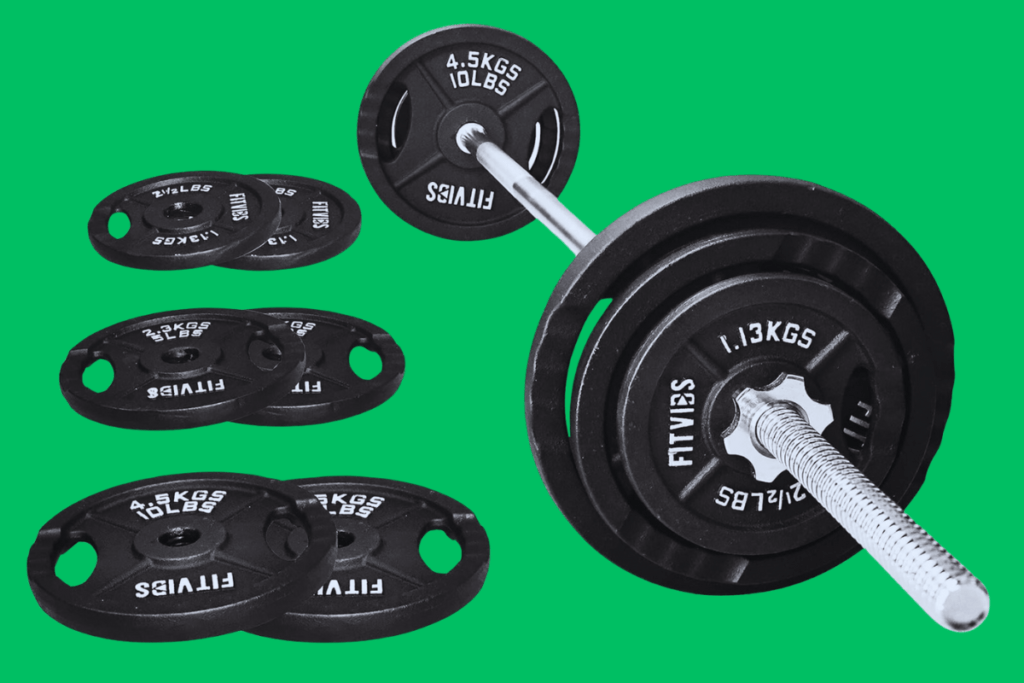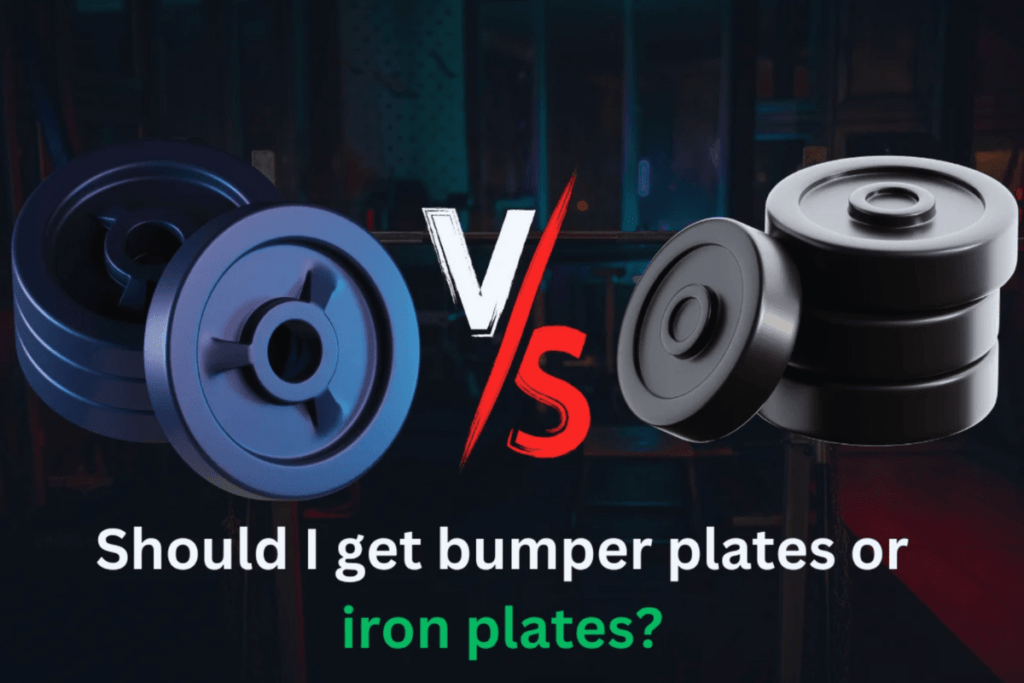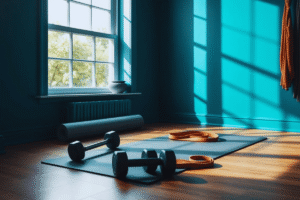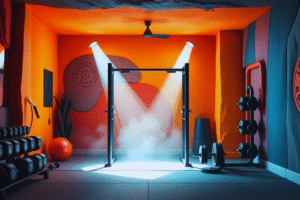There are some factors you should think about choosing bumper plates and iron plates. You must maintain your weightlifting requirements. This is a complete article to help you in making a perfect decision:
Bumper plates
Bumper plates are a specific kind of weight plate. They are mainly used for heavy functional training and Olympic weightlifting.

There is a complete overview of the best bumper plates. It will help you to understand their features, benefits, and plans:
Elements of Best Bumper Plates:
Material Composition: Often, bumper plates are composed of a metal structure covered in rubber or heavy rubber. Their construction prevents the floor. The plates help not to damage when dropped from above.
Size and Diameter: The bumper plates’ diameter does not grow with an increase in weight. Olympic weightlifting routines are made possible by consistency, such as snatches and cleans. It ensures that the barbell remains at the proper height.
Weigh Accuracy: The weight of bumper plates is constructed according to international standards. These are necessary for IWF tournaments. Training consistency and competitive fitness depend on this accuracy.
Color Coding: Usually, bumper plates measuring 25 kg are red, and plates worth 20 kg are blue and continued. This category is based on weight. Finding and loading the necessary weight more rapidly is made easier as a result.
Durability and longevity: Bumper plates are designed to prevent breaking or deforming. Even prevented after suffering repeated drops and high-impact training. When it comes to dealing with drops from above, they are more durable than regular iron plates.
Reduced Noise: Compared to iron plates, bumper plates make less noise. This is a useful feature for places like home gyms or commercial buildings. Especially in those places where reducing noise is very important.
Versatility: Bumper plates are used for a variety of fundamental strength training exercises, such as bench presses, deadlifts, squats, etc. Bumper plates are commonly used for Olympic lifts like cleans and snatches. They adapt to different training environments.
The advantages of best bumper plates
Safety: Bumper plates lower the risk of damage to the lifter and the floor by reducing the weight. Even you can use rogue bumper plates for more purposes.
Floor Protection: As bumper plates are made of rubber, they protect floors from damage. It makes them suitable for use in homes or gyms with flimsy flooring.
Training Intensity: Bumper plates improve and emphasize the development of speed and power. They work perfectly for strong, dramatic lifts.
Consistency: Bumper plates give accurate weight and bar height. And it is necessary for continuing training progress and mastering challenging lifts.
Think About The Following things To Select the Best Bumper Plates:
Cost: Because of their unique design and longevity, bumper plates are more expensive than regular iron plates.
Space & Storage: More space is required for the storage of bumper plates. Because of their greater and heavier size compared to iron plates. Before making an order, take into account the storage options and available space.
Training Environment: CrossFit boxes, Olympic weightlifting gyms. And home gyms are the best locations for bumper plates. If you have noise reduction and floor protection are top priorities.
Weight Steps: Verify that your bumper plates offer your training objectives and development. They also follow the weight increments required to meet Usually, each dish contains at least 5 kg (11 lbs) to 25 kg (55 lbs).
Lifters and athletes committed to Olympic weightlifting. It also works for functional training and high-intensity training. Bumper plates are a great option. They can be used in a variety of training events. Because they have enough strength, flexibility, and safety. If you have any doubt about bumper plates, think about your training goals. Think about your available space and your budget. They are especially helpful if you feel that safety should always come first. If you have a desire to practice high-impact exercise. As well as you are fond of regular progress.
Iron plates
Iron plates are a classic choice for weightlifting and strength training. It offers durability, affordability, and versatility.

You can detect characteristics, advantages, and factors surrounding iron plates. There are significant directions:
Qualities of Iron Plates: Cast iron is a common material for iron plates. It is solid all around and has a center hole for the barbell sleeve. They are available in different weight increments and sizes. It ranges from tiny fractional plates to extreme discs.
Weight Accuracy: The weight of iron plates can differ significantly. Particularly in older or less expensive models. But for steady training growth, high-quality iron plates are typically precise and dependable.
Durability: Iron plates are noted for their ability to resist deterioration. Under regular training conditions, they maintain or deformed.
Versatility: Iron plates can be used for a variety of isolation exercises. Especially squats, deadlifts, bench presses, and other weightlifting exercises. For strength training programs, they offer a solid foundation and framework.
Cost-effectiveness: In general, iron plates are more affordable than bumper plates. Especially when buying larger sets. They make sense for lifters on a tight budget or those who want to improve their at-home exercise gear.
Notice Noise: When dropped, iron plates can make greater noise than bumper plates. This might done while lifter training is in public areas or other circumstances. Where it’s imperative to reduce noise.
Care: Like other periodic cleaning and rust reviews, iron plates don’t need extra care. They can last longer and retain their functionality and appearance. They have proper storage and maintenance.
Benefits of Iron Plates:
Stability: During squats and deadlift exercises iron plates offer a stable platform for lifts. It also contributes to barbell stability.
Cost-Effectiveness: By buying sturdy weight plates set from them, you can furnish a corporate gym. Or you can build a home gym at a reasonable price.
Traditional Weight Training: Iron plates are useful for exercise. They emphasize the development of muscular mass and progressively increasing overload.
Availability: One can easily find iron plates in conventional sizes. There is a wide range of barbells and training configurations.
Considerations When Choosing Iron Plates:
Protecting the Floor: Wood or tile floors may be damaged by iron plates that are dropped roughly. Mats or flooring that is protected can help lower this risk.
Noise Level: Be aware of the noise produced by falling iron plates, especially in areas where noise reduction is necessary.
Training Style: If your training includes Olympic lifts, you should take extra safety precautions. Then you can buy bumper plates or prefer other weight-reducing exercises.
Iron plates are a strong, adaptable, and affordable option for strength coaches and weightlifters. They are ideal for both home gyms and professional fitness centers. As they offer stability and dependability for a variety of workouts. When choosing between iron plates and other types of weight plates, remember your environment, training goals, and budget. Then make sure they suit your needs and preferences for strength training.
Points to Taking Your Best Decision:
Limit of buy: Iron plates are more affordable and durable. This makes them ideal for conventional weightlifting without the need for sporadic drops. The benefits of bumper plates include floor protection and safety. Though they are initially more expensive.
Space and Noise Considerations: Iron plates are noisier and can cause damage to floors if dropped carelessly. Thus they may need extra security measures or matting around them. Because they are safer and quieter for flooring. Bumper plates are ideal for home gyms or environments where noise and floor protection are matters of concern.
Longevity and Investment: If bumper plates suit your training approach and surroundings, they will provide long-term value. Think about the long-term investment in the context of your training objectives.
Thus, bumper plates are highly recommended. If your main activity is doing CrossFit workouts relay on falls or Olympic lifts.
More Considerations:
Accurate Weighing:
Bumper Plates: Iron plates typically weigh more inaccurately than bumper plates. This helps with exact lifting and development.
Iron Plates: The weight of iron plates can occasionally vary greatly, especially in older or less expensive models. This could have an impact on developing consistent training.
Stability and Portability
Bumper Plates: Because of the rubber construction, bumper plates are thicker and more difficult to transport and store. They take up more space, but they are easier to handle and move.
Iron Plates: Easily kept in small spaces like apartments or home gyms, iron plates are denser and more compact than other materials.
Aesthetics and Feel:
Gym Environment:
Commercial Gyms: Commercial gyms usually select bumper plates. Because they are durable and safe. And they are excellent at minimizing noise, especially in crowded areas.
Home Gyms: The choice depends on your tastes. It depends on your available space and whether you need to protect the flooring in your noisy home.
Necessities for Specialized Training:
Olympic Weightlifting: Bumper plates are necessary for Olympic exercises. Such as snatches and cleans. It was needed when dropping the barbell overhead as usual.
Long-term Investment and Resale Value:
Bumper Plates: Although they were more expensive when they first came out, bumper plates were more valuable in the long run. Their durability and wide range of training capabilities make them recommended.
Iron Plates: It is enough affordable initially. But if damaged or dropped frequently, iron plates may lose value in the market. Then you need to replace as soon as possible.
Safety considerations include:
Bumper plates reduce the possibility of injuries to the lifter and the floor.
Training Progression and Adaptability:
Bumper plates: The capacity to drop bumper plates drives explosive and dynamic training. Must for honing technique and power in Olympic lifts. Through the safe practice at higher loads, they help the advancement of weightlifting.
Iron Plates: Ideal for progressive overload in classic weightlifting exercises. Like squats, deadlifts, and bench presses, iron plates provide steady use. For deliberate motions and exercises their main goal is to be strengthened. They also offer stability.
Community and Gym Standards:
Bumper Plates: Bumper plates are used in CrossFit boxes and Olympic lifting gyms. Bumper plates are preferred for their durability and adaptability in high-intensity training environments. They abide by the rules of the gym, which focus on safety and noise reduction.
Iron Plates: Especially known for their affordability and stability. Iron plates are a common sight at gyms. It specializes in powerlifting and traditional strength training. They meet the needs of lifters who regard regulated movements and strength.
Specialty Plates and Accessories:
Bumper Plates: Sometimes available in models suitable for competition that meet specific weightlifting standards. They may also feature color-coded indicators to help you to change weights faster. This makes it easier to identify between different weights.
Iron Plates: Generally available in standard sizes, an iron plate can have fractional plates—smaller incremental weights—added to it for a more consistent loading sequence. They are straightforward in both shape and function, and they allow a range of lifting patterns.
Considerations for Home Gyms:
Bumper Plates: Perfect for home gyms where noise reduction and floor protection are the main priorities. They accommodate a range of training regimens. Also, they offer exercising persons in communal or residential locations with mental peace.
Iron Plates: These are an affordable and flexible solution for tiny home gym setups. Iron plates are a good choice for lifters. Because they are durable and easy to keep organized. So, choose iron plates if you have limited space or specific training habits.
Conclusion
Think about these aspects of your personal needs and preferences when choosing plates. Consider what will complement your training style, support your fitness objectives, and blend well with your training area. Whether choosing bumper plates or iron plates, prioritize safety, effectiveness, and long-term durability.
Your choice should align with your training environment, budget, and goals. Bumper plates are ideal for Olympic lifts, especially where noise reduction and safety matter. On the other hand, iron plates can be a cost-effective option if versatility and affordability are your main concerns.
To make informed decisions and reach your fitness goals efficiently, keep these points in mind.
Want more expert tips on home gym gear, training strategies, and fitness hacks?
Subscribe to our newsletter and get the latest insights delivered straight to your inbox!











43 Comments
cheap amoxicillin sale – buy amoxicillin online amoxicillin buy online
cheap amoxicillin – https://combamoxi.com/ buy amoxicillin generic
buy fluconazole medication – https://gpdifluca.com/# fluconazole canada
diflucan 100mg generic – fluconazole 200mg cheap buy diflucan generic
order cenforce 50mg pill – buy generic cenforce cenforce pills
cheap cenforce 100mg – https://cenforcers.com/# cenforce 50mg ca
tadalafil troche reviews – https://ciltadgn.com/# canadian pharmacy online cialis
Cialis Online Access – Trusted Solutions for Men’s | Tadal Access – cialis online canada ripoff cialis for bph insurance coverage
tadalafil (tadalis-ajanta) reviews – https://strongtadafl.com/ tadalafil without a doctor’s prescription
how long before sex should you take cialis – do you need a prescription for cialis cialis free trial phone number
zantac buy online – https://aranitidine.com/# cheap ranitidine 150mg
viagra super force 100mg 60mg pills – strongvpls how much does 50 mg viagra cost
sildenafil 100 mg oral jelly – https://strongvpls.com/# order viagra online safe
I couldn’t turn down commenting. Adequately written! purchase furosemide without prescription
The reconditeness in this ruined is exceptional. https://gnolvade.com/
With thanks. Loads of knowledge! https://gnolvade.com/
I couldn’t resist commenting. Warmly written! prednisone dosage for colitis
This is the kind of glad I get high on reading. https://ursxdol.com/synthroid-available-online/
Greetings! Very useful suggestion within this article! It’s the scarcely changes which liking obtain the largest changes. Thanks a lot for sharing! https://ursxdol.com/clomid-for-sale-50-mg/
More posts like this would make the blogosphere more useful. https://prohnrg.com/product/lisinopril-5-mg/
More text pieces like this would insinuate the web better. https://prohnrg.com/product/lisinopril-5-mg/
The thoroughness in this draft is noteworthy. https://aranitidine.com/fr/viagra-professional-100-mg/
The depth in this serving is exceptional. on this site
I’ll certainly carry back to read more. https://ondactone.com/spironolactone/
This is the description of content I enjoy reading. https://ondactone.com/spironolactone/
More delight pieces like this would create the web better.
meloxicam for sale
This is the amicable of serenity I take advantage of reading.
https://proisotrepl.com/product/domperidone/
With thanks. Loads of conception! http://web.symbol.rs/forum/member.php?action=profile&uid=1170912
Thanks for putting this up. It’s okay done. http://www.orlandogamers.org/forum/member.php?action=profile&uid=29101
order forxiga 10 mg without prescription – forxiga 10mg us how to buy forxiga
forxiga 10mg tablet – site buy dapagliflozin generic
orlistat cost – xenical drug orlistat pills
purchase xenical online cheap – https://asacostat.com/ buy orlistat 120mg without prescription
More articles like this would make the blogosphere richer. http://www.haxorware.com/forums/member.php?action=profile&uid=396482
More articles like this would pretence of the blogosphere richer. http://web.symbol.rs/forum/member.php?action=profile&uid=1175070
You can shelter yourself and your stock by being wary when buying medicine online. Some pharmacy websites function legally and put forward convenience, privacy, sell for savings and safeguards to purchasing medicines. buy in TerbinaPharmacy https://terbinafines.com/product/imitrex.html imitrex
You can shelter yourself and your dearest by way of being cautious when buying pharmaceutical online. Some pharmacopoeia websites manipulate legally and put forward convenience, secretiveness, cost savings and safeguards as a replacement for purchasing medicines. buy in TerbinaPharmacy https://terbinafines.com/product/keppra.html keppra
With thanks. Loads of conception! acheter stromectol en ligne
More posts like this would force the blogosphere more useful. TerbinaPharmacy
This is a theme which is forthcoming to my fundamentals… Numberless thanks! Faithfully where can I upon the contact details an eye to questions?
I am in fact thrilled to gleam at this blog posts which consists of tons of of use facts, thanks towards providing such data.
Zu den weiteren Aktionen, mit denen unsere Nutzer weitere Boni
wie Freispiele oder Bonusguthaben aktivieren können, zählt
zum Beispiel unser Treueprogramm. Sobald der Verde Casino no deposit Bonus aktiviert wurde,
ist ein Umsatz mit dem Faktor x3 (75 €) erforderlich,
ehe das Guthaben in echtes Geld umgewandelt wird und somit zur Auszahlung bereit steht.
Auch darüber hinaus ergibt sich für Nutzer
des Verde Casinos immer wieder die Gelegenheit, einen pnenden Bonus erhalten zu können. Hier finden die Kunden eine abwechslungsreich zusammengestellte Spielesammlung, die
alle Bereiche der Casinospiele einschließt. Die Mindesteinzahlung wurde bei allen Zahlungsmethoden auf 20 Euro festgesetzt.
Diese Sondercodes bieten oft deutlich höhere Bonusbeträge
oder zusätzliche Freispiele, die nicht im Standardangebot enthalten sind.
Verde Casino Promo Codes kommen mit spezifischen Bonusbedingungen,
die verstanden werden müssen, um die Boni erfolgreich freispielen zu können. Das Willkommenspaket ist besonders spielerfreundlich gestaltet, da die Mindesteinzahlung für die
erste und dritte Stufe nur 10 Euro beträgt. Einzahlungsboni kommen oft
mit zusätzlichen Vorteilen wie Freispielen für beliebte Slot-Spiele.
Zusätzlich lohnt es sich, zwischen Einzahlungsboni, Freispielen und VIP-Deals zu variieren,
um langfristig Vorteile zu sichern. Wichtig ist, nur verifizierte Stellen zu nutzen, denn nur dann
ist ein Verde Casino promo code ohne einzahlung
auch wirklich gültig.
Wenn Sie noch relativ neu bei Verdecasino sind und sich im Level “Leprechaun” befinden, beträgt der Cashback-Koeffizient
3%. Es lohnt sich für Bestandskunden, regelmäßig Zeit im Casino Verde online
zu verbringen. Der Bonus muss 40-mal umgesetzt werden, die Freispiele nur 30-mal.
Insgesamt beinhaltet der Verde Bonus bis zu 1200
Euro und 220 Freispiele. Verde gehört zu den Casinos, bei denen der Willkommensbonus für Neukunden so
groß ausfällt, dass er in mehrere Komponenten geteilt wird.
Diese können einen Bonus für die Registrierung erhalten und
ihre ersten Spins auf Kosten des Hauses genießen.
References:
https://online-spielhallen.de/marvel-casino-umfassende-erfahrungen-tests-2024/
Spieler können mit Echtgeld oder Kryptowährungen spielen. Melde
Dich noch heute an, sichere Dir Deinen Willkommensbonus und
erlebe, warum Crazybuzzer Casino zu den Top-Adressen Deutschlands gehört.
Jedes Level öffnet neue Türen und bringt zusätzliche Anreize, regelmäßig zu spielen. Crazybuzzer Casino auf
Mobilgeräten bietet dieselben Boni, Aktionen und Zahlungsmethoden wie die Desktop-Version. Crazybuzzer Casino bietet Dir das volle Spielerlebnis auch unterwegs.
Ja, selbstverständlich bietet die Online Spielothek aus dem
Hause Gauselmann die beliebten Merkur Slots an. Denn CrazyBuzzer Slots ist im Besitz der deutschen Slot-Lizenz
– dem Anbieter ist es somit gestattet Online Spiele legal anzubieten. Neukunden dürfen sich bei der Ersteinzahlung bei der Online Spielothek über eine Gutschrift von 100% bis zu
100€ freuen. Andererseits überzeugt der Anbieter mit seinem lukrativen Willkommensbonus samt gratis Wettguthaben. Der Kundenservice ist
eine der großen Stärken von Crazybuzzer Slots.
Da CrazyBuzzer Slots in Besitz einer deutschen Lizenz ist, handelt es sich bei der Online
Spielothek um einen seriösen Anbieter.
Aufgrund der aktuellen deutschen Glücksspiellizenz
können CrazyBuzzer und andere Online Spielotheken in Deutschland derzeit keine Tischspiele wie Roulette, Blackjack oder andere klassische Casino Spiele anbieten.
Obwohl die Spielothek derzeit keine Tischspiele oder Live Dealer Optionen aufgrund der
deutschen Lizenzbestimmungen anbietet, bleibt das Slot-Angebot umfangreich.
Sie können alle bekannten Merkur Automaten online spielen, wie zum Beispiele Eye of Horus, El Torero und Magic Mirror oder Jokers Cap.
Bevor Sie von den einzigartigen Willkommensbonus des CrazyBuzzer Casino profitieren und Spielautomaten und Tischspiele spielen können, müssen Sie natürlich
ein Konto erstellen.
References:
https://online-spielhallen.de/bwin-casino-cashback-so-holen-sie-das-beste-heraus/